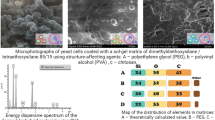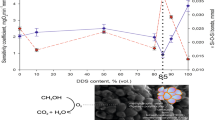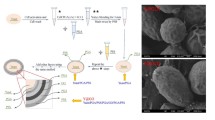Abstract
Biohybrid materials based on ormosil encapsulated yeast cells were synthesized through a one-step sol–gel route with base-catalyst (NaF) using tetraethoxysilane (TEOS), methyltriethoxysilane (MTES) and polyethylene glycol (PEG) with different molar weights as a structure-controlling agent. Phase contrast microscopy and scanning electron microscopy were employed to evidence possible structures of the materials. The addition of PEG during cell encapsulation has induced structural changes within the biohybrids, which depend on PEG molecular weights. The biocatalytic activity of the living hybrids has been investigated by a biosensor which was based on the Clark-type oxygen electrode.
Graphical Abstract





Similar content being viewed by others
References
Ismail WNW (2016) Sol–gel technology for innovative fabric finishing—a review. J Sol-Gel Sci Technol 78(3):698–707
Boury B, Corriu RJP. (2002) Auto-organisation of hybrid organic—inorganic materials prepared by sol—gel process. Chem Commun (Camb) 8:795–802.
Pandey S, Mishra SB (2011) Sol-gel derived organic-inorganic hybrid materials: Synthesis, characterizations and applications. J Sol-Gel Sci Technol 59(1):73–94
Ciriminna R et al. (2013) The sol-gel route to advanced silica-based materials and recent applications. Chem Rev 113(8):6592–6620
Schmidt H, Wfirzburg D (1984) Organically modified silicates by the sol-gel process. Mater Res Soc Symp Proc 32:327–335
Judeinstein P, Sanchez C (1996) Hybrid organic/inorganic materials: a land of multidisciplinarity. J Mater Chem 6(4):511–525
Klein LC, Jitianu A (2010) Organic-inorganic hybrid melting gels. J Sol-Gel Sci Technol 55(1):86–93
Ma Y, Kanezashi M, Tsuru T (2010) Preparation of organic/inorganic hybrid silica using methyltriethoxysilane and tetraethoxysilane as co-precursors. J Sol-Gel Sci Technol 53(1):93–99
Owens GJ et al. (2016) Sol–gel based materials for biomedical applications: article. Prog Mater Sci 77:1–79
Dickson D, Ely R (2013) Silica sol-gel encapsulation of cyanobacteria: lessons for academic and applied research. Appl Microbiol Biotechnol 97(5):1809–1819
Grandi S et al. (2007) Characterisation of a new sol-gel precursor for a SiO2-rhodamine 6G hybrid class II material. J Sol-Gel Sci Technol 41(1):57–63
Shilova OA (2013) Synthesis and structure features of composite silicate and hybrid TEOS-derived thin films doped by inorganic and organic additives. J Sol-Gel Sci Technol 68(3):387–410
Vong MSW, Bazin N, Sermon PA (1997) Chemical modification of silica gels. J Sol-Gel Sci Technol 8(1):499–505
Ferrer ML et al. (2003) Biocompatible sol-gel route for encapsulation of living bacteria in organically modified silica matrixes. Chem Mater 15(19):3614–3618
Veres R et al. (2016) Gamma irradiation effect on bioactive glasses synthesized with polyethylene-glycol template. Ceram Int 42(1, Part B):1990–1997
Boehm HP (1980) The chemistry of silica, solubility, polymerization, colloid and surface properties, and biochemistry. Angew Chemie 92(4):328
Niu X et al. (2013) “Fish-in-Net”, a novel method for cell immobilization of zymomonas mobilis. PLoS ONE 8(11):e79569. (1–11)
Meunier CF, Dandoy P, Su BL (2010) Encapsulation of cells within silica matrixes: Towards a new advance in the conception of living hybrid materials. J Colloid Interface Sci 342(2):211–224
Ponamoreva ON et al. (2015) Yeast-based self-organized hybrid bio-silica sol–gels for the design of biosensors. Biosens Bioelectron 67:321–326
Kamanina OA et al. (2014) Synthesis of organosilicon sol-gel matrices and preparation of heterogeneous biocatalysts based on them. Russ J Appl Chem 87(6):761–766
Kandimalla V, Tripathi V, Ju H (2006) Immobilization of biomolecules in sol–gels: biological and analytical applications. Crit Rev Anal Chem 36(2):73–106
Thevenot DR, Toth K, Durst RA, Wilson GS (2001) Electrochemical biosensors: recommended definitions and classification. Biosens Bioelectron 16:121–131
Kamanina OA et al. (2016) Silica sol-gel encapsulated methylotrophic yeast as filling of biofilters for the removal of methanol from industrial wastewater. Enzyme Microb Technol 92:94–98
Acknowledgements
The reported study was funded by Russian Foundation for Basic Research and Tula Region Government according to the research project No. 16-43-710183.
Author information
Authors and Affiliations
Corresponding author
Ethics declarations
Conflict of interest
The authors declare that they have no competing interests.
Electronic supplementary material
Rights and permissions
About this article
Cite this article
Lavrova, D.G., Kamanina, O.A., Machulin, A.V. et al. Effect of polyethylene glycol additives on structure, stability, and biocatalytic activity of ormosil sol–gel encapsulated yeast cells. J Sol-Gel Sci Technol 88, 1–5 (2018). https://doi.org/10.1007/s10971-017-4333-z
Received:
Accepted:
Published:
Issue Date:
DOI: https://doi.org/10.1007/s10971-017-4333-z




